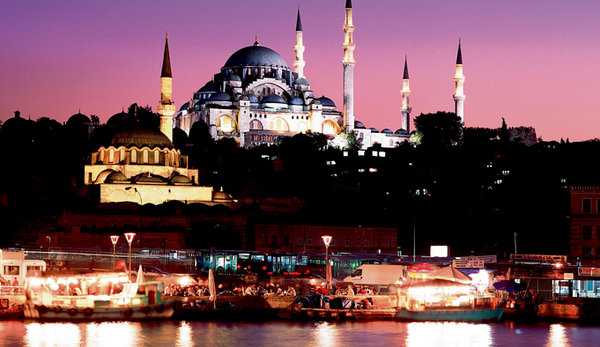ISTANBUL: MEDUSA’S HEAD IS upside-down, her snake-hair rippling above the water. The savage beauty – whose look could turn you to stone – is floating above a cistern: the universal word for tank which gains something murky in translation to Irish-English because of its very specific use here.

ANCIENT BEAUTY Sultan Ahmed Mosque at night PHOTOGRAPH: THINKSTOCK
But this cistern is a magical, cavernous underground cathedral where stone columns – Ionic, Doric and even leafy Corinthian – stand calmly in the still, vast bath. Medusa heads have been carved at the bases of two of the columns: one sideways and one upside down – the reason apparently being to ward off evil spirits (although it could have been practical: supporting the columns better in these positions).
So much is heavily marketed in our world, skewing our expectations (and, if you are disappointed because descriptions have been overblown, too bad: they’ve got your money now), that when something does turn out to be gorgeous, you reap one of life’s sublime surprises.
A waste-water storage facility isn’t as grand a prospect as a mosque or cathedral, but the Basilica Cistern’s proximity to the Blue Mosque and Hagia Sophia, in the old part of Istanbul, brings tourists here as an also-ran.
There are taps outside the Blue Mosque (or Sultan Ahmed Mosque), in recesses in the 17th-century stone wall, where worshippers can clean themselves, as they must do before addressing their God, although the evident lack of people using this very public facility suggests that many nowadays undertake the task at home before being called to prayer. The next task is to take off your shoes – having passed the funeral area outside the entrance – then pad around on the carpet within.
The blue is truly wonderful, the azure ceiling like a brilliant mosaic sky. But its full effect is filtered through thousands of wires hanging from the ceiling to support lamps that dangle just above head height. Tourists are held back, behind a wooden barrier, from the worshipping area where a man stands alone on a far platform, bending in prayer.
In Hagia Sophia – across a courtyard – a stray cat sits on a platform at the front of the mosque showing that this vast, majestic building can easily accommodate all-comers, all the while retaining its stature and capacity to delight. Tourists teem through, walking up its sloping stone-floored tunnel to reach the upper level where a fresco of Jesus has eyes that follow you around the room. The idea was that he was always watching you: be good.
The building has seen many visitors in its nearly 2,000 years of existence. It started as a Greek cathedral, later becoming a Roman Catholic church and then a mosque before being secularised in 1931. It is now a museum.
And that’s illustrative of Istanbul, which spills across water, spanning the Bosphorus and Golden Horn waterways. Symbolically cleaved at the conjunction of Europe and Asia, it is the only city in the world on two continents. Crammed with an estimated 13.5 million people, it has a personality that reflects its geographical positioning.
It feels like a city hankering for the perceived benefits of a westernisation – although, is that gloating I sense from the newsreader presenting the troubles of Greece? – while retaining a strong eastern identity. Christian and Muslim traditions rub shoulders, in a country where the Muslim faith is widely followed but not enshrined in law.
This situation offers freedom for various levels of expression, starkly illustrated at a traditional Turkish dancing evening which descended into belly dancing by surgically appended women jiggling their breasts and hips audience-wise to the obvious delight of one local man, who hollered and laughed, and practically dribbled, all the while hugging his wife – who wore a long dress and headscarf.
Globalisation, and the fact that the city is now becoming a weekend-break destination for Europeans (with a Turkish Airlines flight from Dublin in just under four hours), will bring a greater western influence.
Istanbul’s old city offers rich Turkish tradition, to the joy of tourists who take advantage of having the must-sees all within a walk of each other, near Hagia Sophia and the Blue Mosque is Topkapi Palace, the vast home of Ottoman sultans for 400 years (1465-1856). In that time they acquired vast hauls of jewel-encrusted garb and household goods and constructed a harem building that could hold 300 women. Here you can drink tea by the Bosphorus or, if you visit in the winter, run into the cafe and warm your hands over a bowl of hot coals.
In the Grand Bazaar you can find beautiful carpets, cushions, fabrics and blown glass, as well as soaps and oils of sensuous plants, although there are now also fake handbags (Tod’s and Mulberry) and the main drag of glass-fronted jewellery shops is more Bond Street than traditional market.
Yet there is a real gem, down near the spice market by the Bosphorus. It is a long, thin street running parallel to the river, where locals buy anything they want from guns, frilly gauze to tie on newborns’ cradles, hammers, cheap runners, spades and spices, to handmade steel extractor hoods. There is also coffee, for which there is a huge queue waiting outside a window where young men packing the precious beans at speed.
All these and more can be found dangling from the tops of stalls that are stuffed with goods as well as at waist level on tables and within the small rooms beyond. Anything you want – historically, culturally, religiously, socially and commercially – you can get in Istanbul.
* City breaks to Istanbul are available from wingsabroad.ie, tel: 01-8719444 or a travel agent. A weekend package with Turkish Airlines, Europe’s Best Airline 2011 ( turkishairlines.com), staying at the Seres Hotel costs from €319pps.

Leave a Reply